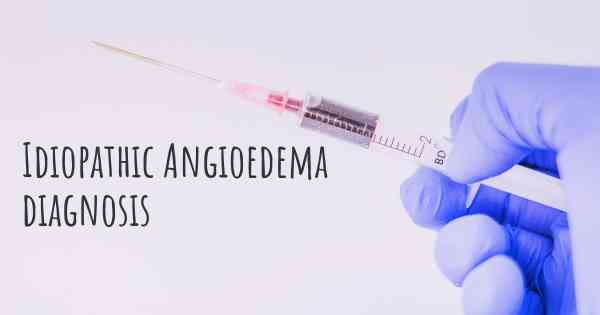How is Idiopathic Angioedema diagnosed?
See how Idiopathic Angioedema is diagnosed. Which specialists are essential to meet, what tests are needed and other useful information for the diagnosis of Idiopathic Angioedema

Diagnosis of Idiopathic Angioedema
Idiopathic angioedema is a condition characterized by recurrent episodes of swelling in various parts of the body, including the skin, mucous membranes, and internal organs. It is considered idiopathic because the exact cause of the condition is unknown. Diagnosing idiopathic angioedema can be challenging as it requires ruling out other potential causes of angioedema and considering various clinical and laboratory findings.
Clinical Evaluation
The diagnosis of idiopathic angioedema begins with a thorough clinical evaluation by a healthcare professional. The doctor will take a detailed medical history, including the frequency, duration, and characteristics of the swelling episodes. They will also inquire about any associated symptoms, such as itching, pain, or difficulty breathing.
During the physical examination, the doctor will carefully examine the affected areas of swelling and assess the patient's overall health. They may also look for any potential triggers or factors that could be contributing to the angioedema episodes.
Exclusion of Other Causes
Since idiopathic angioedema is a diagnosis of exclusion, other potential causes of angioedema must be ruled out before confirming the diagnosis. Some common causes of angioedema include allergic reactions, hereditary angioedema, medication-induced angioedema, and acquired angioedema.
Allergic reactions can be identified through a detailed history of exposure to allergens and specific IgE testing. Hereditary angioedema can be diagnosed through genetic testing and measurement of complement levels. Medication-induced angioedema can be suspected based on the temporal relationship between medication use and angioedema episodes. Acquired angioedema can be identified through laboratory tests, including complement levels and autoantibody screening.
If all these potential causes are ruled out, and no specific trigger or underlying condition is identified, the diagnosis of idiopathic angioedema may be considered.
Laboratory Investigations
Although there are no specific laboratory tests to confirm idiopathic angioedema, certain investigations can help support the diagnosis and rule out other potential causes. These may include:
- Complete blood count (CBC): This test can help identify any underlying infections or abnormalities in blood cell counts.
- C-reactive protein (CRP) and erythrocyte sedimentation rate (ESR): These tests can indicate the presence of inflammation in the body.
- Thyroid function tests: Thyroid dysfunction can sometimes be associated with angioedema, so thyroid function tests may be performed.
- Complement levels: Measurement of complement levels can help differentiate between hereditary and acquired angioedema.
- Autoantibody screening: Screening for autoantibodies can help identify acquired angioedema associated with autoimmune diseases.
Diagnostic Criteria
There are no specific diagnostic criteria for idiopathic angioedema. However, certain features may suggest the diagnosis:
- Recurrent episodes: Idiopathic angioedema is characterized by recurrent episodes of swelling without an identifiable trigger.
- Normal complement levels: Unlike hereditary or acquired angioedema, complement levels are typically normal in idiopathic angioedema.
- Exclusion of other causes: Other potential causes of angioedema should be ruled out through clinical evaluation and laboratory investigations.
Consultation with Specialists
In some cases, consultation with specialists may be necessary to confirm the diagnosis of idiopathic angioedema. These specialists may include allergists, immunologists, dermatologists, or rheumatologists, depending on the specific clinical presentation and suspected underlying mechanisms.
Treatment and Management
Once the diagnosis of idiopathic angioedema is established, the focus shifts to managing the condition and preventing future episodes. Treatment options may include:
- Antihistamines: These medications can help relieve itching and reduce the severity of angioedema episodes.
- Corticosteroids: In some cases, short courses of oral or injectable corticosteroids may be prescribed to reduce inflammation and swelling.
- Epinephrine: In severe cases of angioedema with airway compromise, epinephrine may be administered as an emergency measure.
- Trigger avoidance: Identifying and avoiding potential triggers, such as certain foods or medications, can help prevent angioedema episodes.
- Regular follow-up: Patients with idiopathic angioedema should have regular follow-up visits with their healthcare provider to monitor their condition and adjust treatment as needed.
It is important to note that the management of idiopathic angioedema may vary depending on the individual patient and their specific clinical characteristics. Therefore, it is crucial to consult with a healthcare professional for personalized diagnosis and treatment.








